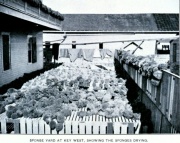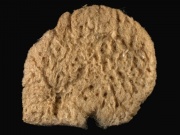Sponge
Description
1) A class of primitive, multicellular animals of the phylum Porifera. Sponges sold commercially are the fibrous skeletal remains of these animals. The sponge skeleton is flexible and absorbent. It is a porous structure composed of siliceous cells bound in a spongin (fibrous protein) matrix. Natural sponges were used by the ancient Greeks and Romans for applying paint, cleaning and for drinking.
2) Absorbent cellulose fibers from several types of fruits or gourds that are used as a washing sponges and filters. See loofa sponge.
3) A foamed plastic that simulates the absorbency of natural sponges. See also cellulose sponge, rubber sponge and PVA sponge.
Synonyms and Related Terms
1. spongia officinalis; Spongia graminea; poriferan; svampedyr (Dan.); Schwämme (Deut.); esponja (Esp., Port.); éponge (Fr.); poriferi (It.); spugne (It.); sponsdieren (Ned.); g¹bki (Pol.); porifera (Port.); svampdjur (Sven.)
Additional Images
Authority
- Wikipedia, the free encyclopedia, at http://www.wikipedia.com Comment: http://en.wikipedia.org/wiki/Sponge (Accessed Nov. 9, 2005)
- G.S.Brady, Materials Handbook, McGraw-Hill Book Co., New York, 1971 Comment: p. 753
- Richard S. Lewis, Hawley's Condensed Chemical Dictionary, Van Nostrand Reinhold, New York, 10th ed., 1993
- Van Nostrand's Scientific Encyclopedia, Douglas M. Considine (ed.), Van Nostrand Reinhold, New York, 1976
- Random House, Webster's Encyclopedic Unabridged Dictionary of the English Language, Grammercy Book, New York, 1997
- The American Heritage Dictionary or Encarta, via Microsoft Bookshelf 98, Microsoft Corp., 1998





